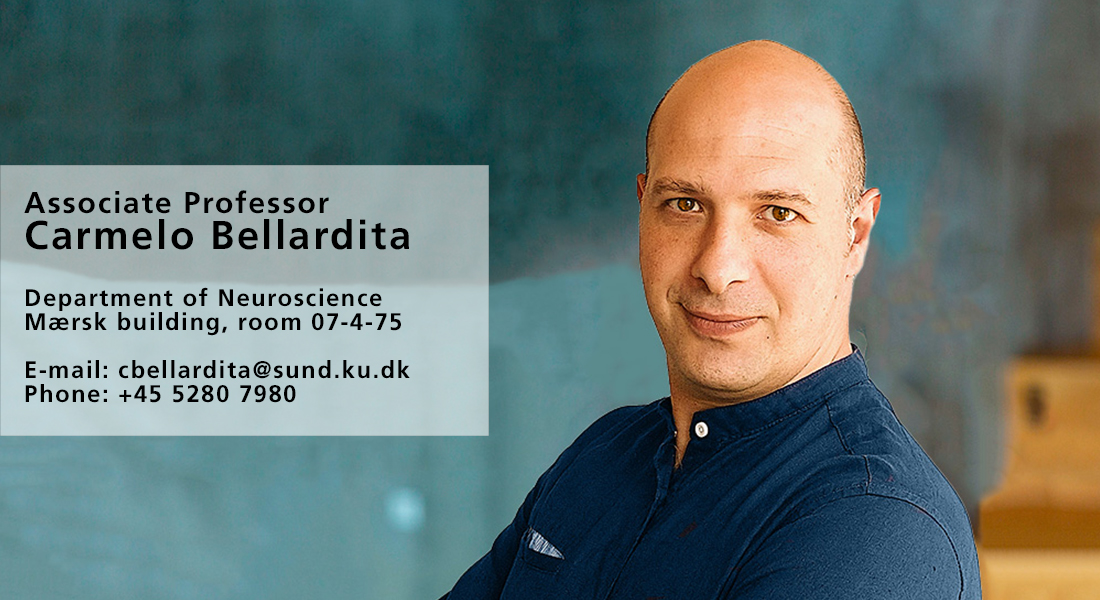Bellardita Lab
We study neural circuitries driving movements and the neural alterations underlying spasticity and motor paralysis after spinal cord injury. We believe this strategy will allows us to identify innovative interventions to restore function in paralyzed individuals.
Effortless actions such as walking or even grabbing a cup of coffee are daily activities that nevertheless represent some of the most sophisticated accomplishments of the mammalian motor system. The capacity for movement is simply at the center of most behaviors. Because movement is the only physical output of the brain, it is also what becomes so obviously affected after spinal cord injury, resulting in chronic paralysis and spasticity.
My research merges molecular and systems neuroscience approaches to investigate how the nervous system generates coordinated movements and the key changes at the cellular and network levels underlying spasticity and motor paralysis after spinal cord injury. Through a combination of basic and translational research with advanced behavioral profiling, mouse intersectional genetics, optogenetic, electrophysiology, and anatomical investigation the laboratory aims to bridge the gap between a fundamental understanding of neural circuitries controlling movements and the development of effective therapeutic interventions for motor recovery in people with spinal cord injury.
-
Malwade S., Gasthaus J., BELLARDITA C., Andelic M., Moric B., Korshunova I., Kiehn O., Vasistha N. and Khodosevich K. Identification of vulnerable interneuron subtypes in 15q13.3 microdeletion syndrome using single-cell transcriptomics. Biological Psychiatry (2021).
-
H. Wu, C. Petitpré, P. Fontanet, A. Sharma, BELLARDITA C., Y. Wang,1 J. A. Heimel, K. Cheung, S. Wanderoy, Y. Xuan, K.Meletis, J. Ruas, O. Kiehn, S. Hadjab, F. Lallemend, Distinct subtypes of proprioceptive dorsal root ganglion neurons regulate adaptive proprioception in mice. Nature Comunication (2021)
-
Marcantoni M., Low P., Fusch A., Kiehn O., BELLARDITA C.. Early delivery and prolonged treatment with nimodipine prevent spasticity after spinal cord injury. Sc. Transl. Med. (2020).
-
BELLARDITA C., Caggiano V., Leiras R., Caldeira V., Fuchs A., Bouvier J., Löw P, Kiehn O. Spatiotemporal correlation of spinal network dynamics underlying spasms in chronic spinalized mice. eLife (2017).
-
Caggiano v. Leiras R., Goñi-Erro H., Masini D., BELLARDITA C., Bouvier J., Caldeira V., Fisone G., Kiehn O. Midbrain circuits that set locomotor speed and gait selection. Nature (2018).
-
BELLARDITA C., Kiehn O. Phenotypic characterization of speed-associated gait changes in mice reveals modular organization of locomotor networks. Current Biology (2015).
Current and previous positions
From 2023: Associate professor-group leader
2018-2022: post-doc, assistant professor, University of Copenhagen.
Education
2012-2017. Post doc fellow, Karolinska Institute, Stockholm, Sweden.
2009-2012. Ph.D. in Neurophysiology, University of Milan, Italy.
2000-2008. M.Sc. Medical Biotechnology, University of Milan, Italy.
We integrate different strategies to form a cohesive and multidimensional approach for understanding the neural basis of behavior, the effects of spinal cord injury, and potential avenues for intervention. We believe that by combining advanced techniques with genetic and viral tools, we can advance our knowledge of neural circuitry and enhance treatments for spinal cord injury.
Spinal cord injury: transection or contusion (infinite Horizon impactor) at cervical, thoracic, or sacral levels. We investigate the effects of the injury on skilled and stereotyped voluntary movements of the forelimbs (skilled movement as grasping), hindlimbs (stereotyped movements as locomotion) tail (voluntary and spastic movements) and trunk.
Behavioral profiling: tests to evaluate motor performance (walking, swimming, beam walking, treadmill, rope, pipe, ladder ect.) of the animal as well as tests for anxiety, depression, and other indirect consequences of brain/spinal injury. This approach helps us to address not only the physical aspects of motor function but also the broader psychological and emotional implications of spinal cord injuries.
Monitoring of neural activity: Electrophysiology (patch-clamp, local field potential, optotagging, electromyography) and calcium imaging are the main strategies to investigate the role of a specific subset of neurons in a defined behavior. We take advantage of the genetic tools available for mice and combine distinct reporter mice or use viral approaches to express opsins, calcium indicators, and fluorescent labeling in a marker-specific fashion.
Neuromodulation: as a powerful tool to unveil causal relationships between neural activity and behavioral responses, neuromodulation provides insight into the fundamental mechanisms at play. We employ perturbation of neural activity at different time scales (optogenetic and chemogenetic) with different strategies to block distinct cellular targets (pharmacological interference or viral delivery). These multifaceted approaches not only elucidate the neural underpinnings of behavior but also hold promise for translating research insights into impactful therapeutic interventions for motor impairments of spinal or supraspinal origins.
Personalized rehabilitation protocols: In helping to translate biological discoveries into therapeutic interventions for SCI, we try to adapt assistive technologies to individual characteristics. For this, we use real-time extraction of performance features (encompassing metrics like body position, stance phase, and step cycle frequency) and use them as dynamic triggers for closed-loop stimulation (electrical or optical) of specific brain regions. Additionally, we use electrophysiological signals (muscles or selected brain regions) to extract behaviorally relevant features of neural activity and further refine the precision and efficacy of intervention.
Neural Signal Processing: association and eventually causation of neural activity and behavioral action is our experimental aim. We harness the potential of combining large datasets of neural activity with imaging analysis (behavioral tests, calcium imaging, anatomical investigation, electrophysiology) using computational approaches. Affiliation to the Pioneer Center for Artificial Intelligence and a deep interest in signal and imaging processing are a core signature of all laboratory members.
Lab members
| Name | Title | Job responsibilities | |
|---|---|---|---|
| Search in Name | Search in Title | Search in Job responsibilities | |
| Carmelo Bellardita | Associate Professor | Bellardita Lab |
|
| Chang Hui Simone Lin | Laboratory Assistant | Bellardita Lab |
|
| Elisa Pfannenmueller | Research Assistant | Bellardita Lab |
|
| Emma Kragelund Christensen | PhD Fellow | Bellardita Lab |
|
| Iryna Vesth-Hansen | Laboratory Technician | Bellardita Lab, Kiehn lab |
|

